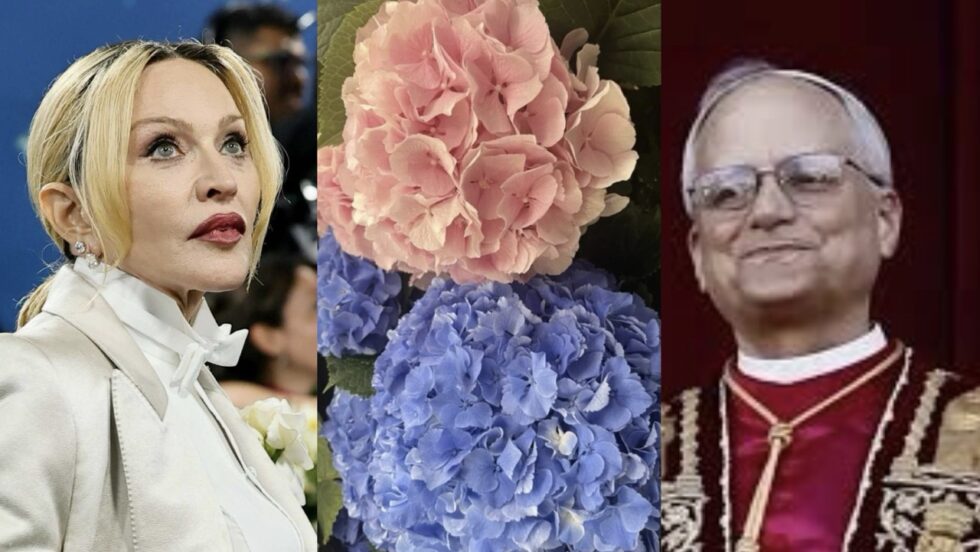Why Does Madonna Hate Hydrangeas – and Which Flowers Link Her to the Pope

The famous Venice incident in which Madonna openly criticised the hydrangeas she was handed still captures the attention of fans and media worldwide. G.business, citing noweinformacje.pl, notes that the singer’s controversial remark has become a symbol not only of blunt honesty but also of the differing meanings flowers can hold in popular culture and religious tradition.
The scandal in Venice: microphone, flowers, and candour
The story began on 1 September 2011 during the 68th Venice International Film Festival. While attending a press conference, Madonna accepted a bouquet of hydrangeas from a fan. Smiling, she leaned towards someone beside her and — unaware that her microphone was still on — said:
“I absolutely loathe hydrangeas. He obviously doesn’t know that.”
The recording went viral within hours, circulating across TV channels and social media. CBS News reported that Madonna’s management responded swiftly, stating that the artist had the right to like or dislike any flowers but simply preferred other kinds. No apology was issued.
From hydrangeas to the Vatican – an unusual link
In recent months, Madonna’s name has appeared in a very different context. According to The New York Times, the singer is distantly related to Pope Leo XIV — described as “ninth cousins, various times removed.”
Moreover, in one of her public posts, Madonna urged the Pope to personally visit Gaza to “bring light to the children before it’s too late.” The appeal was covered by international media, including ABC News.
Which flowers link the Pope
In the Vatican, flowers have a long-standing symbolic role:
- Madonna Lily (Lilium candidum) – In 2014, Pope Francis received seeds of this flower from Israeli scientists. They were cultivated to bloom precisely for the Feast of the Annunciation. The Madonna Lily symbolises purity, innocence, and divine grace.
- White rose – The Pope has repeatedly received white roses, often interpreted as a spiritual sign of hope, for example in connection with Saint Thérèse of Lisieux.
These flowers stand in strong contrast to the hydrangea that Madonna openly dislikes, underscoring how differently floral symbols can be perceived.
Possible reasons for Madonna’s dislike
Madonna has never officially explained her dislike for hydrangeas. Some horticultural experts suggest she may have been disappointed by the often poor blooming of certain varieties in continental climates. For Hydrangea macrophylla, spring frosts can damage buds, resulting in sparse flowers. Other speculations — such as allergies or personal associations — remain unconfirmed.
Symbolism of the hydrangea
The hydrangea (Hydrangea) carries rich, varied meanings in the language of flowers, depending on culture and colour. In Europe, it traditionally symbolises gratitude, beauty, and grace, as well as generosity — its large, round flower heads representing abundance and prosperity. In Japan, where hydrangeas have been cultivated for centuries, they are considered a sign of sincere feelings and apology, rooted in a legend of an emperor gifting hydrangeas to his beloved as an act of remorse.
Colour-specific meanings include:
- Blue hydrangeas – constancy, loyalty, sometimes remorse and understanding.
- Pink hydrangeas – deep emotions, love, romance.
- White hydrangeas – purity, renewal.
- Purple hydrangeas – abundance, wealth.
This complex symbolism contrasts sharply with Madonna’s blunt rejection, making the Venice incident one of the most memorable “flower moments” in pop culture.
From a hot-mic moment in Venice to a public appeal to the Pope, Madonna’s name is tied both to one of the world’s most popular garden flowers and to blooms of deep religious symbolism in the Vatican. While the hydrangea remains a point of distaste for her, the Pope often surrounds himself with symbols of purity and hope — the Madonna Lily and the white rose — whose meanings extend far beyond gardens.
Stay connected for news that works — timely, factual, and free from opinion — and insights that matter now: Why Jack Daniel’s Is Betting on Blackberry Whiskey – and What It Means for the Market
